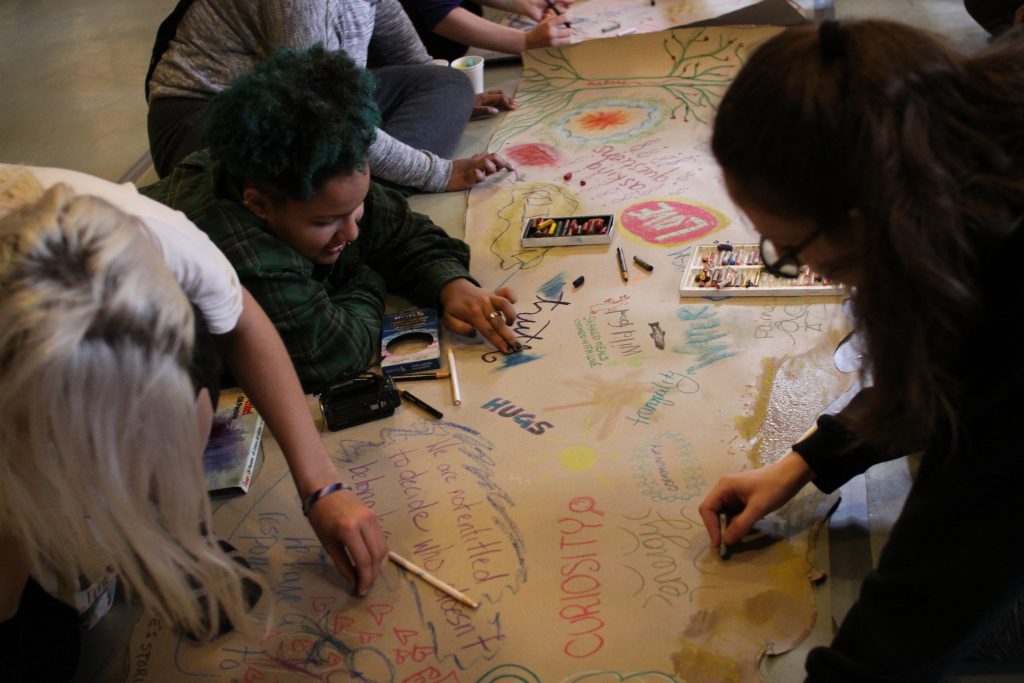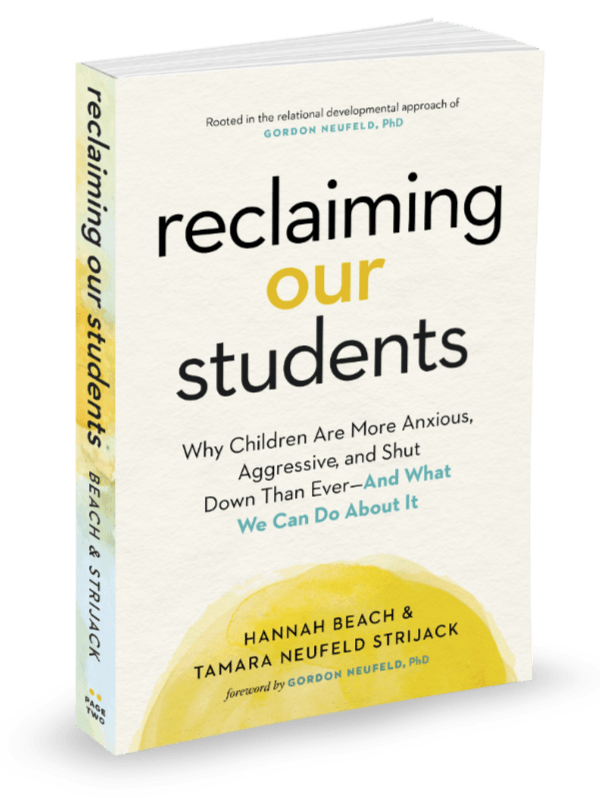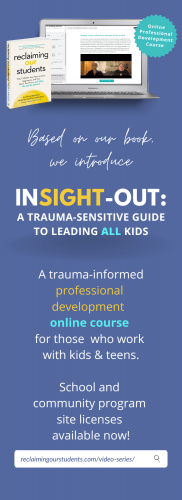Our kids are experiencing an emotional crisis.
Children are more anxious, aggressive, and shut down than ever. We are seeing clear evidence of this in our schools, our homes, our neighbourhoods and our community spaces. The situation has become so dire that our newspapers are literally writing stories about elementary school-aged children punching, kicking and biting their teachers¹. In fact, 54% of Ontario teachers surveyed in 2017/18 reported these experiences – and I know from my work across Canada that these problems are endemic in every part of our country.
Child experts and psychologists are being interviewed on radio talk shows and podcasts as we try to understand the roots of this crisis and what we should do. And, as teachers and helping professionals try to respond – or frankly, just try to get through the day – there are more and more ideas as to why this is happening and how we can create change. I know that my own inbox is filled with newsletters and blog posts that propose character education and prescriptive solutions. They promise things like “Seven steps to help children learn emotional health,” or “How to teach children to communicate peacefully during conflicts.”
If only it were so easy as teaching kids to follow a series of steps, or to apply a framework to manage their emotions like adults. If only adults were able to manage their emotions in these ways!
Emotional Health Cannot be “Taught”
Why can’t we “teach” kids how to be emotionally healthy? The answer to this question lies in understanding what emotions are and what it means to be emotionally healthy.
Emotions – happiness, sadness, fear, love, anger, etc. – are physiological, instinctive and involuntary processes that happen inside us. We all have them. Our emotions play a pivotal role in how we respond, behave, and interact with our world – whether we are aware of them or not.
Our feelings make us aware of the emotions we are experiencing. Our feelings are the conscious messages that we receive from our emotions that let us know what we are experiencing. In order to be emotionally healthy, we must:
-
-
- be aware of our emotions – which means that we must be able to feel them
- be able to express our emotions
- be able to recognize and respect the feelings that others express to us
-
I know that seems like a daunting list – but the most important part is that emotional health starts with feeling. This is not an intellectual process that can be taught out of a textbook. Building emotional health calls for experiences that put us in touch with the full spectrum of human emotions – even the ones that we often try so hard to avoid.
I love how Dr. Gordon Neufeld distills this concept to its fundamental core:
“The essence of the issue regarding emotional health and well-being is that children need to feel their emotions, even their most vulnerable ones. There is no humanity without feeling, no maturation without feeling, no resilience without feeling, no adaptation without feeling, no empathy without feeling.”
– Dr. Gordon Neufeld
Everything about Dr. Neufeld’s framing of emotional health rings true for me and what I have witnessed in my experiential work with children for the past 25 years. The root cause of the emotional crisis and resulting behavioural issues we see in our homes, schools and communities every day is that children are losing their feelings.
Think about it: how often do we resort to tactics like systems of rewards and punishment to get kids to “be good”, only to be faced with comments like “Whatever,” or “I don’t care,” or “It doesn’t matter”? Or how often do we hear “I don’t know” when we ask a child why they deliberately disobey us or hurt someone? We are getting these kinds of responses because so many children literally are not feeling their emotions. But that doesn’t mean that they are not still driven by their emotions. Even if we are not conscious of our emotions through feelings that clue us into what is happening inside us, we are still driven to act upon them. This is very confusing when it happens to us as adults – and it is even more so for children.
Change doesn’t begin with managing our emotions as an intellectual process that we systematically think through in the heat of the moment! Change – true, deep, long-lasting change – is something that comes from the inside out. It begins with feeling our emotions, being truly aware of them, having the space to express them, and then acting on them in ways that are appropriate. It is at the emotional level that the deepest, most long-lasting changes occur. And it is on this level that we have to engage our kids, if we want to support their emotional well-being.
So how do we help our kids find their feelings?
It starts with relationship
We need to help our kids find their feelings in the most human way possible.
Through 25 years of experience in developing experiential programs for children, I have learned that this starts with building positive relationships with the children we work with every day. Whether you are a teacher, social worker, or a helping professional, research now clearly shows that a safe emotional connection with a caring adult is the best way to protect our children’s hearts. One strong, trusting relationship with a caring adult has the power to positively impact a child’s emotional health and well-being forever. When children feel deeply cared for, this supports them to develop their own caring feelings which makes them naturally more sensitive to the emotional needs of others.
This might sound incredibly simple, or even obvious. It might also sound “soft,” or “too easy” to be true. It is anything but that. The fact is, the way that we deal with troubling child and youth behaviours today – through systems of rewards and punishment, or by trying to be “friends” with children and have them see us as their peers – are not helping the problem. At best, these approaches are ineffective. And at worst, they actually exacerbate the problem, because they alienate us from the very children that we are trying to support.
Instead, we have to find our way back into relationships with the children in our care that make them feel safe with us, so that they can then be open to our guidance. We need to be their safe place, the place where they feel safe enough to take down the box around their hearts. And once we do that, we have an opportunity to make meaningful change in their lives.
And, our feelings need to play
 Just as important as building strong relationships with children is providing them with opportunities in which their feelings can come out to play. In other words, we need to provide them with emotional playgrounds. And in my experience, the most powerful emotional playgrounds of all are the arts – but not in the way that most of us think of them.
Just as important as building strong relationships with children is providing them with opportunities in which their feelings can come out to play. In other words, we need to provide them with emotional playgrounds. And in my experience, the most powerful emotional playgrounds of all are the arts – but not in the way that most of us think of them.
From the very beginning of time—as we drew on cave walls, danced around fires, shared stories, sang songs, and sculpted clay—adults and children alike have been expressing themselves through the arts. Cultures are created over time, holding the wisdom of what is needed to sustain the emotional health of individuals and communities. The fact that every traditional culture has developed rituals of singing, sharing stories, and dancing together is not a coincidence. These art forms have served as expressive outlets that bring people together to release what needs to be released and to share in the collective reflection of what it means to be human. Simply put, they bring us to our feelings, and to the feelings of one another. And these experiences are essential to healthy emotional development.
The profound impact of the arts on the emotional health and well-being of our children and broader communities is now coming back to our attention through a global paradigm shift. Where once the arts were seen as “extras” in curricula and community programs, researchers and experts in emotional health are beginning to understand the extraordinary power of the arts to awaken feeling, support emotional growth, and in doing so, connect us to one another. This might feel like a surprising revelation today – but if we consider historical cultural practices over thousands of years, we begin to see that artistic rituals and practices that have been woven into our lives are integral to healthy human development.
Human beings have a deep need to express what is inside of us so that we may become known and make visible to others our inner worlds. This expression helps us make sense of who we are and to bring us into the world of another. Artistic experiences are where we can truly feel our emotions in unparalleled ways. We listen to music that moves us, or watch great films that bring us catharsis. We share stories that take us on journeys of emotion —sadness, joy, loss, pain, and hope—offering glimpses into the experiences of others and of what it means to be fully human.
When artistic experiences are about process, rather than outcome, they can become playgrounds for our feelings. When we offer children opportunities for artistic expression in ways that are truly playful and that are held by the safety of our relationship – i.e. in ways that don’t make them feel pressure to create something “good” or “perfect,” but simply to be who they are and share that with us and others – we support their healthy emotional development. And when they feel connected to us through a strong relationship – when we become their compass point – that is when these experiences will result in the most profound changes. The emotional health that emerges from these experiences is the fruit of relationship and play – and as such, it is profound and long-lasting.
Where do we go from here?
No matter how much we wish for prescriptive steps and strategies to support the emotional health of our children, it simply is not the way people work. We are filled with emotion. We are messy and complicated – and we need to stop trying to affect change through our heads.
What do we need as humans? We need to be connected and we need to be safe to feel.
Is this messy? Yes, absolutely, wonderfully so.
And in the complicated messy place in which our feelings are alive, this is where we become beautifully and imperfectly human. This is where we can feel the range of our emotions. This is where we may feel our sadness and discover our resilience. This is where we may feel our joy and be vulnerable enough to be hopeful. This is where we can sense one another’s humanity. And this is emotional health.
I’m looking forward to digging more deeply into these concepts and sharing my thoughts, ideas and stories from working with children and youth from all walks of life, as well as professionals in the fields of education, social work, and community building. Systemic change that supports the emotional health of children is possible – and it begins at a very human level, in everyday one-on-one interactions between adults and the children in their care.
There is another way. I’d love you to join me.

 PS: Educators are facing immense challenges, now more than ever – but as individuals, we have the power to create great change, even at this time. Our number one job, right now, is to build strong relationships and emotional safety for our students. Learn how through a practical new book and activity guide, Reclaiming Our Students: Why Children Are More Anxious, Aggressive and Shut Down Than Ever – And What We Can Do About It. Available now, online, and in stores everywhere! www.reclaimingourstudents.com
PS: Educators are facing immense challenges, now more than ever – but as individuals, we have the power to create great change, even at this time. Our number one job, right now, is to build strong relationships and emotional safety for our students. Learn how through a practical new book and activity guide, Reclaiming Our Students: Why Children Are More Anxious, Aggressive and Shut Down Than Ever – And What We Can Do About It. Available now, online, and in stores everywhere! www.reclaimingourstudents.com
¹You can read more about it in this CBC article: “New study shows spike in violent incidents in Ontario’s elementary schools”, posted online at https://www.cbc.ca/news/canada/toronto/elementary-school-violence-1.5278838
“it is our feelings that facilitate emotional growth, development, and maturation”
See Antonio Damasio, The Feeling of What Happens (Houghton Mifflin Harcourt, 1999) and Gordon Neufeld, Science of Emotion DVD (Neufeld Institute, 2016).
Subscribe to my newsletter below and never miss another blog post from me!




Fantastic read, you are a leader, doing such impactful work. Your words greatly resonated with me on so many levels of how to create attachment and emotional well-being in our children.
I raised my kids during the Dr. Spock Era, timeouts, only nurse your baby every four hours, don’t let children snuggle with you in bed and on and on. Wanting my children to be extensions and versions of myself instead of helping them be their own sovereign beings. As my children got older I started to follow my gut more in my parenting style. Now being a grandmother of five so much of what Hannah is saying is relevant to how I approach my relationships with my grandchildren and how I see my adult children parenting.
Keep up the good work Hannah… you’re helping parents & teachers esteem children. Your work is so relevant and helping to heal the anxiety crisis in children.
Thanking you !!!
Beautiful, insightful piece of writing! I love the way you describe the arts as being an emotional playground! When I was a child, and to a lesser extent, when my children were growing up, music appreciation and group singing were a part of the curriculum. Instruments and lessons were provided for a nominal fee to all children. Now, I have noticed with my grandchildren, this is no longer the case. It seems the arts in schools are increasingly seen as elitist extra curricular activities available to those who can afford them.